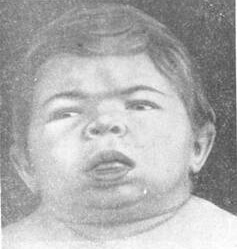Myxedema
 Myxedema is a pathological condition that arises as a result of improper functioning of the thyroid hormone and is manifested as signs of hypothyroidism and hyperthyroid clinical symptoms.
Myxedema is a pathological condition that arises as a result of improper functioning of the thyroid hormone and is manifested as signs of hypothyroidism and hyperthyroid clinical symptoms.
Until recently, such a name of the disease as "myxedema" was not used in the practical work of endocrinologists and was to a greater extent interpreted as "hypothyroidism."At present, this pathological condition is a separate nosological form, and a whole group of doctors of various medical specialties are engaged in the treatment of patients who mark at least one symptom of myxedema.
The risk group for this pathology is predominantly female in the postmenopausal period. It is in this phase that pronounced progressive changes in the hormonal status are noted. Despite this, among the men myxedema is also found, negatively affecting the state of the sexual sphere.
Causes of myxedema
The main etiopathogenetic mechanism for the development of myxedema, as a separate nosological form, is considered to be inadequate thyroid hormone production, which in 90% of cases occurs in the primary form of hypothyroidism. The primary etiopathogenetic form of myxedema is observed in patients with various thyroid diseases of inflammatory, malignant and autoimmune nature. Today, the epidemic type of goiter, accompanied by the development of signs of myxedema, is practically not observed, due to the improvement in the quality of nutrition of patients with the use of iodine-containing products.
Until recently, there was a high incidence of myxedema incidence after an operative manual for total thyroid removal without concomitant administration of thyroidin. At present, this etiologic form of myxedema is practically not found in the practical activities of endocrinologists, since the surgical association of doctors has revised the principles of surgical treatment of pathological changes in the thyroid gland, consisting in the use of subtotal resection, instead of the usual thyroidectomy. However, in some situations, the disease in the long-term course is accompanied by the development of fibrotic changes in the structures of the thyroid gland, which are diffuse, thus creating conditions for the development of symptoms of myxedema. Pathomorphologically myxedema is manifested in the form of development of hypoplasia and fibrotic changes of the thyroid stroma.
In most cases, the mixematous changes are recorded in cases of disorders in the activity of thyroid structures, but along with this, signs of this pathology are also observed in the absence of a background disease. In this case, the diagnosis of idiopathic myxedema is established.
Symptoms of myxedema
Until recently, it was thought that myxedema develops exclusively in persons suffering from hypothyroidism, but currently there are three main clinical and laboratory forms of this pathology: hypothyroid, hyperthyroid, and myxedema in normal hormonal status. Pathological manifestations of myxedema begin to be observed when in all nuclear cells of the human body there begins to be a reduced concentration of thyroxine, which takes a direct part in tissue metabolism.
Clinical manifestations in myxedema are quite diverse and at the same time there is a wide range of pathognomonic symptoms that allow one to distinguish this pathology from other nosological forms. It should be borne in mind that in each specific case, there may be different activity and intensity of clinical manifestations, depending on the depth of hormonal imbalance, the age of the patient, and the presence of concomitant chronic pathologies that aggravate the flow of myxedema.
The most common specific symptom in myxedema is generalized or limited swelling. With myxedema, mucilaginous edema is noted, having an elastic dense consistency, which distinguishes them from edema in renal or cardiac pathology. Typical localization of edematous syndrome is the upper half of the trunk, especially the face and neck. Sometimes the severity of the edematous syndrome is so great that it affects not only the subcutaneous fat tissue, but also internal structures( vocal cords, tracheal rings).Intensive edema is accompanied by a disturbance of sonority of speech, difficulty breathing and swallowing of solid food. Skin covers in the projection of the altered parts of the body also acquire an altered character, marked dryness of the skin, brittle hair and nail plates.
Signs of damage to the structures of the central nervous system in patients with myxedema is the emergence of persistent headaches that do not have a clear localization, paresthesias, violations of all types of sensitivity and mental disorders. A typical sign of myxedema is the development of a propensity for depressive mood and general oppression of the patient's consciousness.
Since thyroid dysfunction is reflected in the state of all organs and systems of the human body, myxedema has a damaging effect on the structure of the cardiovascular system as well. These changes are manifested in the development of dystrophic foci of the heart muscle, coronary sclerosis and cardihaemodynamic disorders in general.
In a situation where the myxedema is accompanied by a pronounced decrease in the production of thyroid hormones, the patient's symptoms are characteristic of the hypothyroid state. Initial manifestations of this pathological condition is a decrease in working capacity, drowsiness, inability to perform the usual physical work. Patients with myxedema often complain of a lack of appetite, a violation of bowel function, a constant feeling of chills and the appearance of muscle pains, as well as stiffness in the projection of large and small joints.
Myxedema has a characteristic feature in young children, since the dysfunction of the thyroid gland affects negatively not only the physical, but also the intellectual-mnestic development of the child. In addition to the lag in mental development, children with signs of myxedema congenital genesis can be observed gross developmental anomalies in the form of congenital deafness and dumbness, dwarfism and disproportionate parts of the body.
Most of the patients with myxedema note a violation of the bowel and urinary system, manifested in the appearance of propensity to constipation, delayed urination and sweating. Despite a decrease in appetite, patients suffering from myxedema have a rapid increase in weight, which can not be corrected by exercise and diet. The influence of myxedematous changes on the sexual system of women is a violation of the regularity of the menstrual cycle, as well as the development of secondary infertility.
Prolonged course of the disease is accompanied by the development of a coma with a high mortality rate of more than 80%.The development of coma contributes to the intake of certain groups of drugs( psychotropic drugs group of neuroleptics), hypothermia. Signs of coma development against the background of myxedema are a sharp decrease in the overall temperature response, respiratory disorders and the presence of pleural effusion, intestinal obstruction and acute renal failure. Patients with this severity of condition are immediately hospitalized for surgical treatment.
A separate clinical-laboratory form of myxedema is pre-tyibial, the occurrence of which is accompanied by excessive production of thyroid hormones. The emergence of this pathology is most often affected by women in the climacteric period and in all cases in this category of patients there is an increase in the antibody titer to thyroglobulin. Pretybial myxedema is accompanied by the development of characteristic changes that allow the experienced doctor to establish the correct diagnosis already at the primary visual inspection.
In the onset of clinical manifestations of the pre-bacterial form of myxedema, the symptoms of skin disorders predominate in the form of the appearance of hyperpigmented areas, foci of gambling and maceration of the skin, having limited dimensions and typical localization in the projection of the anterior surface of one or both shins. In the future, the hyperpigmented areas merge into a single poured erythema, and the skin becomes denser, in comparison with the bordering unchanged areas. In the subcutaneous fat, a large amount of mucous substrate accumulates, as a result of which there is a marked edema of the distal sections of the lower extremities of the dense structure. In addition to the characteristic changes in the skin, in the place of localization of the edema there is a violation of hair growth.
Diagnosis of myxedema
If there is a suspicion of the presence of myxedema, the patient should be directed to the definition of the background disease, which was the provoker of the development of the mixematous changes. As such measures, a laboratory screening of the hormonal status of the patient with mandatory detection of the level of hormones produced by the thyroid gland is used.
As instrumental methods of visualization of the thyroid gland, it is recommended to use ultrasound scanning, which allows detecting focal and diffuse changes in the gland tissue.
Detection of nodular thyroid tissue damage of any site should be supplemented by puncture of the tumor and subsequent histological examination of the punctate.
Treatment of myxedema
All clinical forms of myxedema are subject to pathogenetic treatment with substitution drugs. Already during the first day of receiving substitution therapy, patients notice a significant improvement in their health status, which consists in leveling out the manifestations of hypothyroidism.
Thyroidin is used as a drug of choice for carrying out substitution therapy in a daily dose of 0.3 grams orally. This therapy belongs to the category of satiety and on the achievement of normalization of the basal metabolic rate, it is recommended to transfer patients to maintenance dosages of the drug. It should be taken into account that the improvement of the patient's condition, as well as the normalization of laboratory parameters, is not a criterion for stopping the use of substitution therapy drugs, since myxedema is a chronic progressive disease requiring lifelong correction. The peculiarity of hormone therapy with myxedem is its absolute harmlessness and the absence of drug dependence.
Titration of a dose of thyroidin is the most difficult situation for an endocrinologist, since the use of high doses of the drug can lead to catastrophic consequences for the activity of cardiovascular structures( anginal pain syndrome, acute dilatation of the heart cavities and sudden coronary insufficiency).
The prognosis with myxedema can not be considered favorable under any conditions, since the absolute recovery of the patient never occurs. However, the constant intake of hormonal drugs can prevent possible complications. The congenital form of myxedema is characterized by an unfavorable course and a prognosis regarding normal functioning.
In the pre-bacterial form of myxedema, first of all, use local treatment( glucocorticosteroid ointment type Triderm), eliminating cutaneous manifestations of myxedema.



